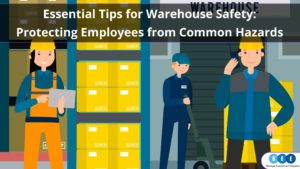
The cold storage PPE industry is essential when it comes to preserving the quality of perishable goods, ranging from food products to pharmaceuticals. These specialized environments, where temperatures often plunge to sub-zero levels, ensure the longevity and freshness of products for consumers worldwide.
Those same conditions that benefit goods can pose significant health risks to the workers operating within them. Cold storage facilities that focus on health and safety not only protect their workforce but also ensure efficient and uninterrupted operations – always an important concern.
Understanding the Risks in a Cold Storage Warehouse
Cold storage warehousing, while essential, introduces unique health risks to workers. One of the most prominent threats is hypothermia, a condition where the body loses heat faster than it can produce, leading to a dangerously low body temperature – if not addressed promptly, hypothermia can impair thinking, numbing the body and, in severe cases, becoming life-threatening.
Equally concerning is frostbite, where skin and underlying tissues freeze, especially in extremities like fingers, toes, and the nose. If not treated, frostbite can lead to irreversible tissue damage and even amputation.
Given these risks, the importance of proper insulation and protection cannot be overstated – it is not merely about comfort; it’s a critical line of defence against the perils of extreme cold, safeguarding workers’ health and well-being.
Basics of Cold Storage Personal Protective Equipment (PPE)
Cold storage environments require specialized Personal Protective Equipment (PPE) tailored to tackle the challenges posed by extreme cold. Unlike regular warehouses or industrial settings, cold storage can expose workers to temperatures well below freezing. At such temperatures, standard PPE, designed mainly for generic industrial and warehouse safety, will not offer adequate protection against cold-induced hazards.
PPE specific to cold storage is meticulously designed with specialized insulating materials that trap body heat while warding off external cold. This ensures that workers remain warm, their body temperature regulated, and are shielded from potential cold-related ailments. In addition, cold storage PPE often integrates moisture-wicking properties to handle sweat, a crucial feature since dampness can drastically reduce insulation efficiency.
Think about it in these terms – standard PPE focuses on preventing accidents, while cold storage PPE combines this with thermal protection, creating a shield against the frigid environment.
Key Cold Storage PPE Items and Their Importance
Some of the more common cold storage PPE are:
1. Insulated Gloves
Hand dexterity is fundamental in most warehouse tasks. However, in cold storage settings, preserving this dexterity without compromising on warmth is a challenge. Insulated gloves are the solution – crafted with multiple layers, they provide the necessary insulation to guard against frostbite while maintaining the flexibility needed to grip and handle items. These gloves often come with water-resistant exteriors to prevent dampness from compromising their insulation properties.
2. Thermal Headgear
We lose a significant portion of our body heat through our heads, and this is particularly dangerous in freezing environments. Thermal headgear, ranging from balaclavas to insulated beanies, is great at trapping body heat. Not only do they offer protection against the cold, but they also shield ears from potential frostbite – a common cold-induced ailment.
3. Insulated Jackets and Trousers
Core body temperature regulation is the first line of protection when it comes to hypothermia. Cold storage clothing like Insulated jackets and trousers incorporate breathable materials to prevent overheating while ensuring optimal insulation – with special attention being paid to seam placements, ensuring cold air ingress is minimized.
4. Protective Footwear
Feet are also vulnerable to the cold. Protective footwear designed for cold storage environments is more than just insulated – it combines warmth, grip, and moisture-wicking capabilities. This ensures that workers not only have warm feet but also a steady footing on potentially slippery cold storage floors.
Features to Look for in Cold Storage PPE
When selecting Personal Protective Equipment (PPE) for cold storage environments, it’s not just about warmth – it’s about ensuring functionality and durability amidst icy conditions. Here’s a rundown of features to consider:
- Material Types for Optimal Insulation: The core of any cold storage PPE is its insulating material. Look for materials like Thinsulate, PrimaLoft, or other synthetic insulators known for their high warmth-to-weight ratio. These materials trap heat efficiently while being lightweight and less bulky.
- Waterproofing and Moisture-wicking Capabilities: In cold environments, dampness can be a formidable enemy, drastically reducing insulation effectiveness. PPE with waterproof exteriors and moisture-wicking interiors is vital. This dual-action feature ensures external moisture stays out while internal sweat is drawn away, keeping workers dry and warm.
- Ergonomic Design for Comfort and Functionality: Working in bulky clothing can be restrictive, slowing down workers. Cold storage PPE should have an ergonomic design, contouring to the body while allowing freedom of movement – features like articulated joints, adjustable cuffs, and gusseted panels can make a significant difference in both comfort and task efficiency.
Importance of Regular PPE Maintenance
Maintaining cold storage warehouse PPE isn’t just about cleanliness – it’s the key to consistent protection. Proper cleaning is essential as accumulated dirt or oils can diminish the insulating properties of the gear – always follow manufacturer guidelines for washing, as certain materials might require specific care.
Equally vital is storing your safety equipment in a dry, cool place, away from direct sunlight, which can degrade certain fabrics over time. Regular inspections for wear and tear, such as frayed seams or thinning insulation, can prevent potential breaches in protection.
Remember, consistent care of your PPE ensures its longevity and, most importantly, the safety it’s designed to provide.
Training and Awareness
Beyond just providing PPE, the real key to cold storage safety lies in educating workers. Proper training sessions should emphasize the correct ways to wear, adjust, care for, and store PPE, ensuring maximum protection.
It is also vital that workers can recognize the early signs of cold-related illnesses, such as numbness, shivering, and fatigue – an informed team can act quickly, potentially saving a colleague from conditions like hypothermia or frostbite. Regular workshops and refreshers should be conducted, highlighting that safety isn’t just about equipment but the knowledge and awareness to use it effectively.
Legal and Compliance Aspects
Adhering to cold storage PPE legal and compliance standards isn’t just about paperwork – it’s about safeguarding lives. The Health and Safety Executive (HSE) has published guidelines ensuring that PPE meets stringent standards, guaranteeing workers the protection they deserve.
Other industry bodies also have best practice requirements, including:
- BS7915:1998 ‘Ergonomics of the thermal environment – Guide to design and evaluation of working practices for cold indoor working environments.’
- ISO 15743:2008 ‘Ergonomics of the thermal environment – Cold workplaces – Risk assessment and management’
Compliance with these standards not only minimizes potential legal repercussions but also fosters a culture of safety and responsibility within the organization.
Regular safety audits should ensure that PPE is up-to-date, effective, and used appropriately.
Cold Storage PPE – What Next?
The right PPE plays an instrumental role in shielding workers from the severe risks associated with extremely low temperatures – so cutting corners or settling for subpar gear is a gamble with grave consequences. Employers and workers must both recognize the non-negotiable need for top-notch cold storage PPE.
For more information on maintaining essential warehouse and storage safety, visit SEE Racking Inspections.





